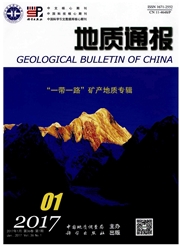

 中文摘要:
中文摘要:
裂变径迹年代学测试表明,吉隆地区高喜马拉雅约30kin的南北剖面上锆石裂变径迹年龄介于13~2.4Ma之间,磷灰石裂变径迹年龄介于1.9~0.6Ma之间:在空间上,裂变径迹年龄与高程及纬度都具有正相关关系。综合区域热年代学资料,裂变径迹年代学数据揭示出研究区高喜马拉雅经历了3个阶段的冷却剥露过程:①中新世中期至约13Ma,藏南拆离系(STDS)大规模伸展拆离作用引发的高喜马拉雅岩石区域性的构造剥露;②中新世晚期伴随STDS韧性变形的结束,缓慢冷却剥露阶段;⑧上新世前后,5.8~2.7Ma以来。快速并不断加速的冷却剥露作用。综合对比研究区构造地貌特征及热年代学空间格局,提出上新世以来高喜马拉雅快速并加速的剥露作用,是由流域以河流切蚀为代表的地表作用过程驱动。
 英文摘要:
英文摘要:
Constituting the material majority and high topography of the Himalaya, the Greater Himalayan Slab (GHS) occurs as the best scientific media for revealing the deformation, surface uplift and topographic evolution of the Himalayan Orogenic Belt. This pa- per focuses on the field of the Gyirong area in central Himalaya and relies on fission track (FT) thermochronology in revealing the cooling and exhumation and further related tectonic and topographic information of the GHS. Fission track thermochronology yields zircon FT ages between 13 and 2.4Ma and apatite FT ages between 1.9 and 0.6Ma across a 30km north-south GHS section. Spatially,the FT ages show positive correlation with both elevation and latitude position. In combination with regional thermochronologies, these FT ages suggest three episodes of coohng and exhumation of the GHS. ① Middle Miocene, to -13Ma, regional syntectonic rock cooling by large scale extension of the Southern Tibet Detachment System (STDS); ② Late Miocene slowed cooling by the ceasing of ductile extension of the STDS; ③ approximately since Phocene, from -5.8-2.7Ma, rapid and accelerated coohng. Combined with tec- tonic landform analysis of the Gyirong drainage, the FT thermochronological spatial pattern suggests that the Pliocene rapid cooling was driven by surface processes donfinated by river incision. The regional transition from tectonic to climatic exhumation of the Himalaya may probably imply that the Himalaya had accomplished a significant elevation before Late Miocene, and further drove a significant change in local and even global chmate, which in turn established the base for chmate exhumation of the Himalaya since Phocene.
 同期刊论文项目
同期刊论文项目
 同项目期刊论文
同项目期刊论文
 Episodic exhumation of the Greater Himalayan Sequence since the Miocene constrained by fission track
Episodic exhumation of the Greater Himalayan Sequence since the Miocene constrained by fission track Pre-Rodinia supercontinent Nuna shaping up: A global synthesis with new paleomagnetic results from N
Pre-Rodinia supercontinent Nuna shaping up: A global synthesis with new paleomagnetic results from N Extended stratigraphy, palynology and depositional environments record the initiation of the Himalay
Extended stratigraphy, palynology and depositional environments record the initiation of the Himalay Systematics and palaeoecology of Changhsingian (Late Permian) Ambocoeliidae brachiopods from South C
Systematics and palaeoecology of Changhsingian (Late Permian) Ambocoeliidae brachiopods from South C Climatic and tectonic uplift evolution since similar to 7 Ma in Gyirong basin, southwestern Tibet pl
Climatic and tectonic uplift evolution since similar to 7 Ma in Gyirong basin, southwestern Tibet pl Organic carbon isotope constraints on the dissolved organic carbon (DOC) reservoir at the Cryogenian
Organic carbon isotope constraints on the dissolved organic carbon (DOC) reservoir at the Cryogenian How severe is the modern biotic crisis? - A comparison of global change and biotic crisis between Pe
How severe is the modern biotic crisis? - A comparison of global change and biotic crisis between Pe Environmental determinants and ecologic selectivity of benthic faunas from nearshore to bathyal zone
Environmental determinants and ecologic selectivity of benthic faunas from nearshore to bathyal zone Diagenetic control of magnetic susceptibility variation in Core MD98-2172 from the Eastern Timor Sea
Diagenetic control of magnetic susceptibility variation in Core MD98-2172 from the Eastern Timor Sea Sedimentary geochemistry and provenance of the Lower and Middle Devonian Laojunshan Formation, the N
Sedimentary geochemistry and provenance of the Lower and Middle Devonian Laojunshan Formation, the N Paleogene-Neogene stratigraphic realm and sedimentary sequence of the Qinghai-Tibet Plateau and thei
Paleogene-Neogene stratigraphic realm and sedimentary sequence of the Qinghai-Tibet Plateau and thei Zoophycos composite ichnofabrics and tiers from the Permian neritic facies in South China and south-
Zoophycos composite ichnofabrics and tiers from the Permian neritic facies in South China and south- Palaeoecology and taphonomy of two brachiopod shell beds from the Anisian (Middle Triassic) of Guizh
Palaeoecology and taphonomy of two brachiopod shell beds from the Anisian (Middle Triassic) of Guizh Isotopic evidence for an anomalously low oceanic sulfate concentration following end-Permian mass ex
Isotopic evidence for an anomalously low oceanic sulfate concentration following end-Permian mass ex Provenance record of a foreland basin: Detrital zircon U-Pb ages from Devonian strata in the North Q
Provenance record of a foreland basin: Detrital zircon U-Pb ages from Devonian strata in the North Q Revised conodont zonation and conodont evolution across the Permian-Triassic boundary at the Shangsi
Revised conodont zonation and conodont evolution across the Permian-Triassic boundary at the Shangsi Microbial lipid records of highly alkaline deposits and enhanced aridity associated with significant
Microbial lipid records of highly alkaline deposits and enhanced aridity associated with significant The origin of decoupled carbonate and organic carbon isotope signatures in the early Cambrian (ca. 5
The origin of decoupled carbonate and organic carbon isotope signatures in the early Cambrian (ca. 5 Microbial response to limited nutrients in shallow water immediately after the end-Permian mass exti
Microbial response to limited nutrients in shallow water immediately after the end-Permian mass exti Morphological association of microbially induced sedimentary structures (MISS) as a paleoenvironment
Morphological association of microbially induced sedimentary structures (MISS) as a paleoenvironment Geochemical evidence from bio-apatite for multiple oceanic anoxic events during Permian-Triassic tra
Geochemical evidence from bio-apatite for multiple oceanic anoxic events during Permian-Triassic tra 期刊信息
期刊信息
